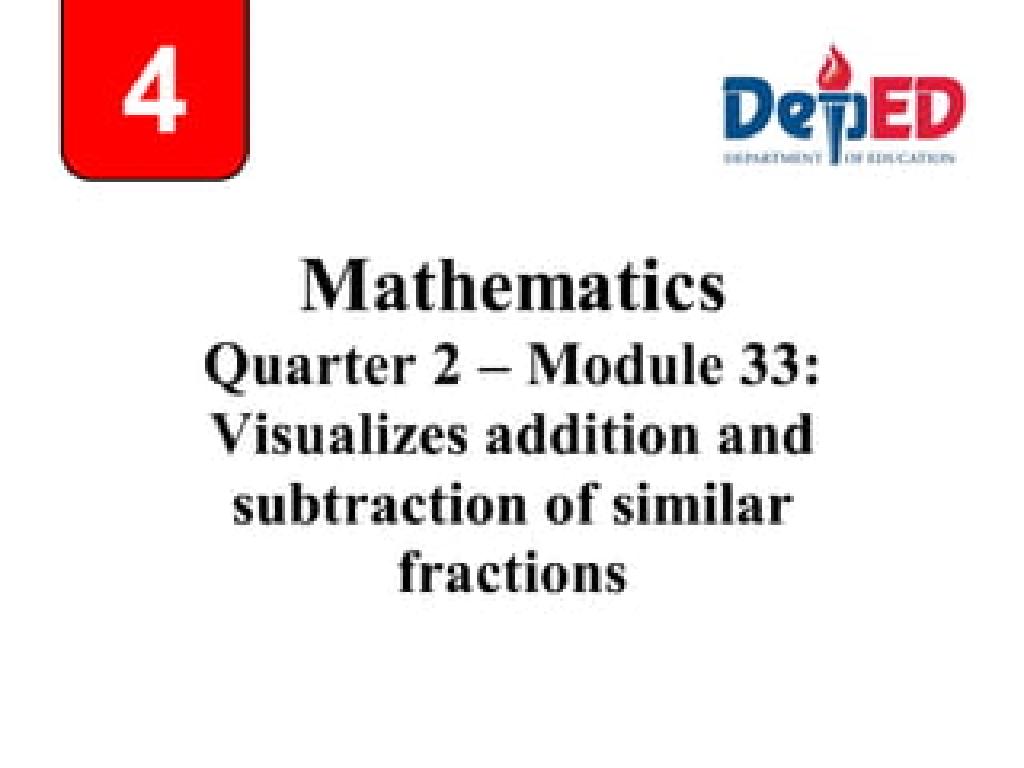Name Angles
Subject: Math
Grade: Sixth grade
Topic: Lines And Angles
Please LOG IN to download the presentation. Access is available to registered users only.
View More Content
Introduction to Angles
– What are angles?
– Angles are formed by two rays meeting at a point.
– Understanding angle concepts
– We measure angles in degrees.
– Angles in everyday life
– Doorways, slices of pizza, clock at 3:00.
|
Begin the lesson by defining angles as the space between two intersecting lines or rays, with a common endpoint known as the vertex. Explain that angles are measured in degrees, which can range from 0 to 360. Use everyday examples to illustrate angles, such as the corners of a room, slices of pizza, or the hands of a clock showing 3:00. These relatable examples will help students recognize angles in the world around them and understand their relevance. Encourage students to think of other examples and to visualize angles in different objects they use or see daily.
Types of Angles
– Acute Angles: Less than 90°
– An angle smaller than a right angle, e.g., 45°
– Right Angles: Exactly 90°
– An angle equal to one quarter turn, e.g., corner of a square
– Obtuse Angles: Between 90° and 180°
– An angle larger than a right angle but not a straight line, e.g., 120°
– Straight Angles: Exactly 180°
– Half a rotation, line segment angle, e.g., straight path
|
This slide introduces students to the basic types of angles they will encounter in geometry. An acute angle is any angle less than 90 degrees, often found in various shapes like triangles. A right angle is 90 degrees and is commonly seen in everyday objects like books and tables. Obtuse angles are those greater than 90 degrees but less than 180, often less common in man-made structures. A straight angle is 180 degrees and can be visualized as a straight line. Ensure students understand each type by showing visual examples and using a protractor to measure angles. Have students practice drawing each type of angle and identifying them in the classroom or at home.
Measuring Angles with a Protractor
– Using a protractor to measure
– Place the protractor’s center on the angle’s vertex, align one ray with the baseline.
– Types of angles to measure
– Acute, obtuse, right, and straight angles.
– Practice with various angles
– Use different angles for hands-on practice.
– Recording angle measurements
|
This slide is aimed at teaching students how to accurately measure angles using a protractor. Begin by demonstrating the correct placement of the protractor on the vertex of the angle. Show how one ray of the angle should align with the zero line of the protractor. Discuss the different types of angles: acute (less than 90°), obtuse (more than 90° but less than 180°), right (exactly 90°), and straight (exactly 180°). Provide students with a variety of angles to practice on, ensuring they understand how to read the measurements correctly. Encourage them to record their measurements to check for accuracy. This hands-on activity will help solidify their understanding of angle measurement.
Naming Angles
– Naming angles by vertex and endpoints
– Angle ABC or B, where B is the vertex
– Using letters to name angles
– Angle A, B, C, where B is the vertex
– Assigning numbers to angles
– Angle 1, 2, 3, often found in diagrams
– Practice with angle names
|
This slide introduces students to the different methods of naming angles, which is a fundamental skill in geometry. Start by explaining that the vertex and endpoints of an angle’s arms are used to name it, with the vertex always listed in the middle (e.g., angle ABC or angle B). Then, discuss how angles can also be named using just letters (e.g., angle A or B or C) when there is no ambiguity. Additionally, angles can be named with numbers, which is a common practice in diagrams with multiple angles. Encourage students to practice naming angles using these methods, and provide examples on the board for them to work through. This will help solidify their understanding of geometric notation and prepare them for more complex concepts.
Angle Relationships
– Adjacent Angles: Common side & vertex
– Two angles that are side by side sharing an arm and a corner point
– Complementary Angles: Sum to 90°
– If angle A and B are complementary, A + B = 90°. Example: 30° and 60°
– Supplementary Angles: Sum to 180°
– For supplementary, A + B = 180°. Example: 70° and 110°
|
This slide introduces students to different angle relationships. Adjacent angles are next to each other, sharing a common side and vertex. Complementary angles are any two angles that sum up to 90 degrees, which is the total of a right angle. Supplementary angles, on the other hand, add up to 180 degrees, the total of a straight angle. Use real-life examples like corners of a book for adjacent angles, a right angle triangle for complementary, and a straight road for supplementary to help students visualize these concepts. Encourage students to find these angles in the classroom or at home for a practical understanding.
Class Activity: Angle Hunt
– Find angles in the classroom
– Measure angles with a protractor
– Use the protractor’s baseline and center point for accurate measurement
– Classify the discovered angles
– Is it acute, right, obtuse, or straight?
– Discuss findings with the class
|
This interactive activity is designed to help students apply their knowledge of angles in a practical setting. Students will search the classroom for examples of acute, right, obtuse, and straight angles. They will then use a protractor to measure the angles, ensuring they understand how to align the protractor correctly with the angle’s vertex and base line. After measuring, students should classify each angle according to its type and be prepared to discuss how they determined each classification. As a teacher, circulate to assist with protractor use and to facilitate discussions. Possible variations of the activity could include finding angles in groups, drawing angles they find, or even creating a gallery walk of photographed angles with classifications.
Review and Q&A: Angle Essentials
– Recap types of angles
– Acute, obtuse, right, straight, reflex, and full angles.
– How to measure angles
– Use a protractor to measure the degrees between lines.
– Open floor for questions
– Discuss angle importance
– Angles are everywhere! They help in construction, art, and navigation.
|
This slide is meant to consolidate the students’ understanding of angles. Begin by reviewing the different types of angles: acute (less than 90°), obtuse (more than 90° but less than 180°), right (exactly 90°), straight (exactly 180°), reflex (more than 180° but less than 360°), and full (exactly 360°). Demonstrate the use of a protractor to measure angles accurately. Encourage students to ask any lingering questions they might have about angles to clarify their understanding. Emphasize the practical applications of understanding angles in various fields such as architecture, engineering, design, and navigation. This discussion will help students appreciate the relevance of what they have learned.
Homework: Exploring Angles Around Us
– Complete ‘Name That Angle!’ worksheet
– Measure angles of 5 home items
– Use a protractor to find the angles
– Record your angle measurements
– Write down each angle’s degree
– Present one angle measurement in class
– Choose one angle to share with the class
|
This homework assignment is designed to reinforce the students’ ability to identify and measure angles using a protractor. The ‘Name That Angle!’ worksheet will provide practice with naming angles. Students are then asked to find and measure angles in everyday objects at home, which helps them recognize the presence and relevance of angles in their environment. They should record these measurements carefully. Encourage students to be prepared to present one of the angles they measured, explaining how they found it and measured it. This will help them gain confidence in their measuring skills and ability to communicate mathematical concepts. For the presentation, suggest that they think about why the angle is interesting or how it is used in the design of the item.





